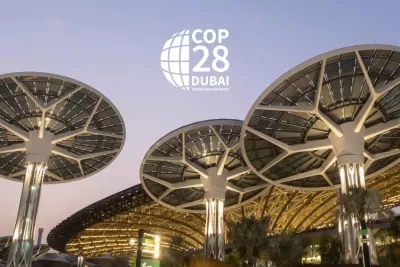UN Climate Summit: The beginning of the end of the fossil fuel era has been heralded

The UN climate summit in Dubai concluded on 13 December after a 24-hour extension. While this year’s COP28 sends a strong signal overall, this should not distract from the weaknesses contained in the final decision, which could jeopardise implementation.
The experts at Germanwatch have conducted an initial assessment of the negotiations, including the most important decisions and events. Their findings are presented here.
Content
- The negotiations and their context: A closer look
- Political sticking points: An overview
- First Global Stocktake delivers important push for the critical decade up to 2030
- Mitigation Work Programme fails to send a positive signal
- Outstanding questions regarding the Just Transition Pathways Work Programme
- GGA framework adopted, but still too weak
- The Loss and Damage Fund: An historic milestone
- Climate finance as a catalyst for success
- Outlook
The negotiations and their context: A closer look
The selection of the United Arab Emirates (UAE) for this year’s COP presidency placed the struggle for natural resources at the centre of negotiations from the very outset. This fact was underscored by the appointment of Sultan Ahmed al Jaber as COP28 President. Al Jaber is the CEO of the Abu Dhabi National Oil Company (ADNOC), as well as a founder of Masdar, one of the world’s largest renewable energy companies. Al Jaber himself is thus reflective of the tension between fossil fuels interests and renewable energy interests – a tension that is broadly observable in the realities of energy policy. Scenarios from the International Energy Agency (IEA) suggest that fossil fuel consumption could peak as early as 2025. Renewables are rapidly expanding in G20 member countries, particularly in China, the US, EU, India, and Brazil. Progress is also being made in the area of energy efficiency – thanks in particular to the electrification of the transport sector and heat pumps in buildings. By contrast, high commodity prices continue to generate record revenues for fossil fuel companies. As long as the profit opportunities of fossil fuels exceed those of green technologies, companies will continue to make large-scale investments in oil and gas.
It was against the backdrop of these tensions that the struggle for a consensus on energy policy at COP28 took place. At the outset of the conference, various questions loomed large:
- Would it be possible for all countries to agree on a transition away from coal, oil, and gas?
- Would Paris signatory states be prepared to further accelerate the rapid growth of renewable energy, storage technologies, and electrolysers in the G20 while also supporting the countries that have been left behind in the green transformation?
In the end, the signatory states agreed to back transformation in that direction in the landmark decision on the Global Stocktake, which is the most important element of the UAE Consensus – even if the support offered to the poorest and most vulnerable countries remains insufficient, and needs to be improved at the next COP. The UAE Consensus acknowledges the need to keep the increase in global average temperatures below 1.5°C (at least after a certain overshoot for a limited time). However, it does not address with sufficient clarity how the corresponding measures can be implemented. Furthermore, the consensus is marked by various loopholes and gaps. For example, it lacks detail concerning how vulnerable countries and people will be assisted to deal with climate change impacts.
In some respects, the Paris agreement’s commitments to global solidarity were honoured at COP28 with the decisions taken regarding the Global Goal on Adaptation (GGA), the Loss and Damage Fund, and the granting of support for a just transition and energy access in poorer countries. However, the foundation for the implementation of these commitments is shaky. For this reason, the Alliance of Small Island States (AOSIS) was on the verge of withholding their support for the UAE Consensus. In the end, the COP President hammered through the decision during the final plenary session in the manner of a CEO, rather than that of a diplomat. This represented a breach of UNFCCC protocol, as the negotiating group was not present. The AOSIS ultimately restricted themselves to voicing their displeasure in the meeting minutes. Overall, the UAE Presidency can be credited with dedication to achieving an ambitious outcome. The host was under enormous pressure from the countries in the region, which were clearly surprised by the seriousness of the debate on phasing out fossil fuels. It may well have taken an oil-rich country to somewhat break down the resistance mounted by other petroleum-exporting nations.
However, the UAE Consensus can only become truly historic if the necessary conditions for implementation are secured in individual countries and in the global community. Specifically:
- Investments in developing new fossil fuel reserves must be prohibited or subject to large risk premiums.
- The regulatory regimes for energy efficiency and renewable energy must be further improved.
- Many more countries must be enabled to participate in the transformation of energy systems and in the transition away from fossil fuels.
- The new value chains that arise as part of this transformation must be regulated to prevent conflicts with human rights and biodiversity. These novel forms of value chains should also promote inclusive forms of prosperity – for example, through well-paying industrial jobs, rather than in raw materials extraction.
At the Leaders’ Summit that took place at the start of COP28, EU Commission President Ursula von der Leyen announced a €2.3 billion investment package for infrastructure in developing countries. While this was a welcome pledge, it is minuscule in relation to the scope of transformation required. An important prerequisite for transformative investment will be to reduce the debt burden of many developing countries, as nearly 60 nations in the developing world are under enormous debt stress. Accordingly, a large number of countries sought to address the debt problem during the negotiations at COP28. However, the discussion of this topic was systematically blocked by China, the largest bilateral lender. Ultimately, the support packages and debt relief measures that are granted to developing countries will determine who wins the tug-of-war between fossil fuel interests and actors in the green economy.
It was also possible to avert the adoption of the low-ambition consensus agreed between the US and China, which would have made no mention of energy efficiency or the abandonment of fossil fuels. While there were fears that the US–China Sunnylands Statement, which was published by the two countries in advance of COP28, might preconfigure the outcome of the negotiations, ultimately it was possible to achieve a more ambitious consensus. Australia and the EU were driving forces in this regard, as they gradually moved the US to a more ambitious position on energy issues. China also showed greater flexibility than initially assumed, as it sought to build a bridge to the more blocking emerging economies clustered around India, South Africa, and the Gulf states.
The necessary pressure on the very large emitters was generated by a broad alliance of 130 vulnerable states and constructive industrialised countries. This once again demonstrated that a groundbreaking outcome can only be achieved at a COP given the formation of a broad alliance that instils the negotiations with the necessary impetus and ambition.
For the first time, greater attention was devoted to the issue of how the trade and financial policies of individual countries or regions could have a potentially negative impact on growth elsewhere. This was a previously unknown dimension of UN climate negotiations. In particular, it concerns the following policies: the EU and UK Carbon Border Adjustment Mechanism (CBAM), the US Inflation Reduction Act (IRA), the EU Supply Chain Act, and EU financial market regulations. This issue was spearheaded by China (which focused on the IRA) and South Africa (which focused on the CBAM). It is unclear whether the UNFCCC is the right forum for this debate – or whether such issues are better addressed by, say, the World Trade Organization. The issue is however likely to play an increasingly important role in the future.
At COP28, the negotiating groups were increasingly complex and less monolithic. This was a highly notable development. For example, the group of Like-Minded Developing Countries (LMDC) acted less cohesively than before. Individual actors in the Arab Group – such as Iraq – have indicated they recognize the need for transformation. Furthermore, among the four BASIC countries, Brazil has proven to be an ambitious actor with an agenda that is increasingly diverging from that of China, India, and South Africa.
Based on the proposal by Eastern European countries, Azerbaijan was selected to host COP29. Next year will thus mark the third time in a row that the conference has been hosted in an authoritarian country that has become rich from oil and gas. This also demonstrates the degree to which these petroleum-rich countries view the UN climate summit as a risk to their business models. At the same time, their influence is pushing the consensus-based UN system to the limits of what it can achieve. Last but not least, the repeated hosting of UN climate summits in authoritarian states is a worrying development for civil society, which is severely restricted in its watchdog function.
The German government, led by the Foreign Office (AA) and the Federal Ministry for Economic Cooperation and Development (BMZ), contributed in four ways to the overall unexpectedly good outcomes of COP28:
- Already in the spring of this year, Germany began intensifying its diplomatic relations with the COP28 presidency in order to convince the UAE to contribute to the new Loss and Damage Fund. This diplomatic work has paid off in several respects. On the one hand, it contributed significantly to the positive initial momentum at COP28. On the other hand, the German commitment of $100 million convinced other donors to furnish an additional $555 million. Even if the commitment made by the UAE to the Loss and Damage Fund failed to mobilise pledges from other rich oil and gas nations, it did send an important signal that this group of countries will need to make contributions in future.
- Germany introduced the idea of a very ambitious global renewable-energy and energy-efficiency target, and this topic achieved wider acceptance thanks to the Petersberg Climate Dialogue. At the beginning of COP28, over 120 countries had already communicated their support for this idea. Accordingly, reference to it in the binding decision text became unavoidable, and it could not be used as a real negotiating chip.
- Within the EU, Germany succeeded in ensuring that the disastrous interim negotiating text tabled by the COP Presidency regarding the Global Stocktake was very quickly rejected by the EU as ‘unacceptable’. Through this, the EU could contribute to assembling the necessary counter forces.
- The German government was once again very active in uniting and focusing the pressure exerted by the High Ambition Coalition (HAC). Fortunately, it was possible to overcome the period of weakness that marked recent months, during which the Chancellery prevented Germany from signing two statements in the run-up to COP28. While the HAC did not produce an official statement at this COP, it mobilised over 130 states in the final hours of the negotiations and this pressure was ultimately essential for reinvigorating flagging momentum and for achieving a groundbreaking outcome with regard to the Global Stocktake, despite the various weaknesses in the consensus that was achieved.
Political sticking points: An overview
First Global Stocktake delivers important push for the critical decade up to 2030
The first Global Stocktake (GST) came to an end at COP28 after a two-year process. The Global Stocktake stood at the centre of the negotiations’ tug-of-war, as it undertook a comprehensive assessment of all relevant areas: mitigation, adaptation, finance, loss and damage, and international cooperation. The negotiations conducted in this regard largely determined the outcome of this year’s COP – unlike in previous years, in which the cover decision always played a decisive role.
The UAE Consensus was preceded by two drafts that differed dramatically in their level of ambition. Tensions revolved around the issue of phasing out fossil fuels. While the first draft still spoke ambitiously of phasing out all fossil fuels, the second draft fell far short of any conceivable minimum consensus. The reaction of around 80% of the negotiating parties, who rejected the draft outright, was correspondingly drastic. The second draft was only supported by Saudi Arabia.
Ultimately, governments were able to agree for the first time on an accelerated and at the same time fair and orderly transitioning away from all fossil fuels in energy sectors in order to achieve net-zero emissions by 2050. This will be accompanied by a comprehensive package of measures, including (1) the planned tripling of globally installed renewable energy capacity, (2) a doubling of the energy-efficiency improvement rate, (3) a significant reduction in non-carbon emissions, particularly methane emissions by 2030, and (4) a reduction in emissions from road traffic. This decision sends a clear political signal for the beginning of the end of the fossil fuel era. It will enable a far-reaching, rapid, and sustainable reduction in greenhouse gas emissions. In this regard, it is important to consider the starting point of each country.
Unfortunately, the package of measures contains various loopholes and sham solutions, including the promotion of ‘low-emission’ technologies like nuclear energy, CCS, CCU, and low-carbon hydrogen. But nuclear energy and carbon capture are ‘pie in the sky’ solutions, as they will not stand a chance in competition with renewable energy and the ongoing electrification of transport and heating. It is important that in the limited potential of CCS is only applied in cases where residual emissions not yet can be avoided. The language recognising that ‘transitional fuels’ can ‘play a role’ in facilitating the energy transition opens the door for natural gas and weakens the agreement achieved to transitioning away from fossil fuels.
In addition to the agreement reached regarding the transformation of the energy sector, the global stocktake decision contains guidance for the next round of Nationally Determined Contributions (NDCs), which are to be submitted by 2025. These new climate targets for 2035 should be aligned with the 1.5°C limit.
An even more ambitious result would have required a support package from the industrialised countries for developing countries consisting of finance, capacity building, and technology transfer. Still, the majority of mitigation investments are concentrated in the G20 and other industrialised nations. Various developing countries have been reluctant to support greater ambition due to concerns about not having enough fiscal leeway to combat energy poverty and promote sustainable development at the same time.
Mitigation Work Programme fails to send a positive signal
Unfortunately, the Mitigation Work Program (MWP) was considerably weakened at COP28. First established at COP26, the MWP was designed to close the gap between ambition and implementation by 2030 and to provide associated guidance. The MWP could have contributed important solutions to the package of energy measures decided as part of the GST.
Instead, it remains to be seen whether this year’s weak MWP decision will set a precedent for the coming years up to 2026 – the current end date for the MWP. If so, this would mean that oil and gas producing countries in concert with China and India will have managed to undermine the MWP and prevent the imposition of further obligations on themselves. This would be regrettable, as the MWP is currently the only forum for discussing mitigation measures in climate negotiations.
Ultimately, the key findings and proposed solutions that emerged as part of the two Global Dialogues of the MWP could not be formally adopted at COP28. As the upcoming dialogues will focus on different topics, some countries could potentially block further discussion on the energy sector, which has already been addressed this year. It remains to be seen whether the slight improvements to the MWP process can prevent a repeat of this COP’s bad experience. It is distressing that the MWP has not been provided with a mandate to work on the measures agreed as part of the GST.
Outstanding questions regarding the Just Transition Pathways Work Programme
The Just Transition Pathways Work Programme (JTWP), which was initiated in Egypt last year, was to receive more specific elaboration at COP28. However, intricate deliberations promptly ensued concerning the scope of the programme’s mandate (including whether the work program was to solely address the workforce or a broader range of issues, including energy access). This left little room for discussing important questions regarding the implementation and goals of the JTWP. It was not possible to arrive at a coherent definition of ‘just transition’.
Industrialised countries, particularly the US, preferred a narrow interpretation of the Paris Agreement. Developing countries, on the other hand, led by South Africa and Brazil, advocated for a broader understanding.
Ultimately, it is a positive development that an agreement has been reached at all and that it combines mitigation with, among other things, the protection of human rights and indigenous populations as well as gender equality. However, the link between these issues is relatively weak and risks being overshadowed by a focus on the workforce. What remains is the concern that the JTWP could be degraded to a mere rhetorical performance, without substantive coherence or a strong anchoring in justice debates.
GGA framework adopted, but still too weak
A key concern of poorer countries that are particularly vulnerable to the climate crisis was the adoption of a framework for the Global Goal on Adaptation (GGA). The adoption of a framework for the GGA must be assessed as a positive outcome of the COP28 negotiations, especially given how difficult these particular negotiations were. Yet, despite energetic efforts by various countries – particularly the African Group – the adopted framework is too weak. The various sub-targets – including those on food security, health, poverty reduction, ecosystems, and infrastructure – have not been formulated with sufficient specificity or outfitted with quantitative indicators. In some cases, the targets even fall short of the Sustainable Development Goals (SDGs). This gap between the GGA and SDGs must now be closed in the new two-year work programme dedicated to developing indicators for the various subtargets.
The GGA framework does not yet provide the necessary orientation for the formulation of regional adaptation measures and associated implementation efforts that aim to significantly improve the resilience of the countries and peoples most affected by the climate crisis. As adaptation plans must be implemented by all countries, Germany also needs to devote additional attention to this topic.
The continuing shortfall in funding for planning and implementing adaptation measures in developing countries should also be emphasised in this regard. The thematic sub-targets also continue to lack specific funding goals.
The Loss and Damage Fund: An historic milestone
COP28 began with an historic decision to operationalise the Loss and Damage Fund (LDF). This decision lays the foundation for helping countries and people who are particularly threatened by the climate crisis to cope with loss and damage caused by climate change. The endowment of the LDF with sufficient funding would mean an important step toward greater climate justice. The UAE and Germany started by pledging $100 million each – the minimum amount required to launch the fund. Other countries have pledged an additional $500 million, making the total around $700 million. However, these pledges are not nearly enough to cover the estimated annual need of up to $580 billion in developing countries by 2030. The first meeting of the LDF Board will take place in January 2024. Critical issues remain unresolved, including how resources are to be allocated to recipients. The Board will also need to address weaknesses in its governance mechanism, including the lack of specific orientation to human rights, and the need to ensure civil-society participation in board meetings. The World Bank must accept the conditions set for it as interim trustee.
Climate finance as a catalyst for success
As usual, finance issues played a prominent role and were a major sticking point in the COP28 negotiations. Among the interlocking triad of ambition concerning mitigation measures, adaptation, and finance, the granting of financial support was a prerequisite for an ambitious outcome. At COP29, a veritable ‘showdown’ will take place on the issue of climate finance as part of the decision on a New Collective Quantified Goal (NCQG) for the period after 2025. The issue influenced the manoeuvring of all negotiating parties at this year’s COP.
Despite the positive signal sent by the operationalisation of the LDF, the negotiations on climate finance took place under less than ideal conditions: The UNEP presented figures on the growing shortfall in adaptation finance; according to the OECD, the volume of adaptation finance fell by approximately 15% in 2021. The failure of some industrialised countries to honour their finance commitments in prior years also served to dampen the mood. To restore confidence, the industrialised countries needed to send a clear signal in Dubai that the negative trend for climate finance would be reversed. However, they failed to do so. As a result, the Adaptation Fund fell far short of its minimum finance target of $300 million. Programmatic decisions and adequate, multi-year finance commitments – which are important for the fund’s operation – also failed to materialise. Although Germany once again sought to rally support for the Adaptation Fund at COP28, it was unable to persuade the rich oil states or the majority of industrialised countries to join in. At least industrialised countries have now been called upon to report on their efforts to double adaptation finance. At the same time, it was recognised that even a doubling of finance would fail to meet actual need.
The growing gap between the needs and priorities of developing countries and the financial resources provided and mobilised also stood at the centre of negotiations regarding the GST. While the GST decision recognises this gap and cites estimates of its magnitude, it does not outline a solution for addressing the associated shortfall. Instead, it deploys the usual phrasing to reiterate the obligations of industrialised countries in relation to the developing countries. It also assesses the progress made in mobilising finance. The negotiating parties were reluctant to make any concrete offer of support, in part due to concern this would unduly influence upcoming negotiations regarding the New Collective Quantified Goal (NCQG).
Discussion regarding the NCQG focused on improving procedures in 2024 in order to facilitate the development of the draft negotiating text as early as possible in the run up to COP29. Three additional meetings will be held to develop a ‘substantive framework for a draft negotiating text’. However, the details were left open. An actual draft negotiating text should be drawn up in advance to avoid a last-minute political decision at COP29 that does not reflect the needs and priorities of developing countries.
Alongside adaptation finance and finance for the energy package, another point of controversy was Article 2.1c of the Paris Agreement, which states that all financial flows must be consistent with a pathway towards low greenhouse gas emissions and climate-resilient development. How this provision relates to other articles of the Paris Agreement and thus to the question of how it relates to climate finance, as it is defined in the Agreement’s article 9 will need to be explored further as part of the dialog format that was established at COP27. This dialog format has been extended for an additional two years. However, it was not possible to agree on a binding work programme, as various lines in the negotiations were at loggerheads. For example, it was argued that a possible decision this year should not pre-empt the decision on the NCQG, which is not planned until 2024. In this regard, developing countries have an (at least partially justified) concern that industrialised countries could use this as a distraction from their climate finance obligations if all financial flows come under discussion. Another concern is that full implementation of Article 2.1c could lead to higher cost of capital or additional capital outflows. However, the GST spotlighted crucial aspects of Article 2.1c when discussing the importance of reforming the international financial architecture. Multilateral development banks and other financial institutions are being called upon to increase their green investment and provisioning of resources for climate finance. Innovative financial instruments such as taxes are to be implemented with greater speed, and negative incentives are to be reduced.
Outlook
COP29 in Azerbaijan will mark the third year in a row that the UN Climate summit has been held in an oil-rich nation. While this is highly problematic unto itself, another cause for concern is that Azerbaijan is ranked 157th out of the 180 countries in Transparency International’s corruption index.
The hosting of COP29 in Azerbaijan makes it all the more important to develop a strong international momentum for ambitious climate policy – both at COP and beyond. Brazil has a special role to play in this regard. During this year’s negotiations, it was evident that Brazil is already making robust preparations for its hosting of COP30 in 2025. At COP28, the Brazilians participated as consensus-oriented actors, as characteristic of the Brazilian school of diplomacy. At the same time, the Brazilians have been seeking to achieve the next level of climate ambition with their ‘Mission 1.5’ initiative. As part of the GST decision, it was decided that the UAE, Azerbaijan, and Brazil would form a troika to organise activities in the run up to COP30. The partnership between these countries will seek to strengthen international cooperation and enhance the ambition of the global community as the next Nationally Determined Contributions (NDCs) are being prepared (Roadmap to Mission 1.5). Given the economic interest that the UAE and Azerbaijan have in continued reliance on fossil fuels, Brazil will play an important role in rallying support for the Roadmap to Mission 1.5. Brazil’s efforts are motivated in no small part by the concern that a critical tipping point for the survival of the Amazon rainforest could be reached if the 1.5°C threshold is crossed. It has been estimated that a massive die-off of the rainforest would occur at just 2°C above baseline.
Climate policy already stands at the centre of Brazil’s current G20 presidency, alongside the fight against hunger and poverty. In the area of climate policy, the G20 has been devoting major attention to the reform of the international financial architecture. One key issue is to change how representatives are appointed to the decision-making bodies of international financial institutions, with the aim of better reflecting the economic reality of this century. The G20 has also been deliberating on tax issues, the International Monetary Fund, and how to increase the efficiency of climate funds. In line with the dynamics at this COP28, a focus will also be placed on trade issues and how trade policies impact the Global South.
Over the next two years, Brazil has the opportunity to play a key role in mediating the disputes between democratic and authoritarian states. As a recognised ‘honest broker’, Brazil can help to adjust the rules of the game in international politics such that the Global South is afforded equitable participation in decision-making processes and a fairer share of global prosperity. The potentially path-breaking negotiations regarding the NCQG slated to take place next year – the 80th anniversary of the Bretton Woods system – could witness the establishment of a new international system of monetary arrangements that is in tune with the realities of the 21st century. At the same time, this moment of reform could lead to a new institutional framework that better serves the necessary transformation of the global economy.
The necessary reform of the World Bank, IMF, and multilateral development banks (MDBs) in 2024 should be guided by an awareness of the enormous volume of climate finance that is required. In this connection, it will be necessary to introduce new global levies or taxes – e.g. on air travel and maritime transport, or on major fossil fuel emitters. The crux of the matter is that the entities most responsible for polluting the atmosphere must finally be obliged to make an adequate contribution to funding the green transformation. Germany should promptly join the newly established working group that includes Barbados, Kenya, Antigua and Barbuda, Spain, France, and the African Union Commission. In addition, next year there will be a strong focus on ensuring that increasing contributions from industrialised countries for international climate finance are supplemented by contributions from rich emerging economies with high emissions. This debate will initially revolve around oil-rich countries and China.
Many developing countries are struggling by large debt burdens. Germany and the EU should advocate for highly indebted developing countries to receive debt relief. This would help to build trust and credibility. As these countries are mainly indebted to China and multilateral development banks, the advancement of a proposal for MDBs to grant debt relief would signal the seriousness of the EU and other industrialised countries to address this issue. Together with Kenya, Colombia and France, Germany is a co-founder of the Expert Review on Debt, Nature, and Climate. With the aim of renewing the largely dysfunctional debt regime, Germany can set the tone in the debate on the current debt burden, innovative new finance instruments, and the sustainability of future debt.
To enable genuine partnerships, Germany and the EU will have to make structural offers that contribute to the development of new value chains, that help to ensure universal access to electricity and that promote the rise of climate-compatible industry in the Global South. It is crucial for these countries to move beyond acting as mere suppliers of raw materials, and to escape the ‘resource curse’.
These partnerships are additionally necessary to reduce dependence on China. While cooperation with China is necessary to address the climate crisis, the clean energy transition must not lead to a Chinese monopoly in transformative green technologies. Serious partnerships that develop supply chains in the Global South are thus important, as they can encourage diversification, reduce dependency, and strengthen the competitiveness of the economy in Germany and Europe.
At the time of the imminent approach of peak of fossil fuel use and the need to organise the following phase out of fossil fuels, one question that garnered attention on the sidelines of COP was whether the fossil fuel importing countries need an organisation that can serve as a counterweight to OPEC+. Such an organisation could help to prevent unproductive demand-side competition between fossil fuel importers in the scramble for remaining resources, which would help to stabilise prices. Such an organisation could also help to cooperatively accelerate the phasing out of fossil fuels. Last but not least, it would offer a means of overcoming the polarised North–South debates.
Following difficult budget negotiations and a decision by the Federal Constitutional Court that makes fiscal revisions necessary, the German government will have to find solutions for the future as to how necessary investments can be initiated in an accelerated fashion. It would be disastrous if budget cuts were to lead to lower levels of national investment or declines in international climate finance. This would not only harm the climate, but also undermine the global standing of Germany and the EU. Sufficient climate finance is essential for ambitious COP outcomes and long-term partnerships with many actors in the Global South. It also represents a crucial element of Germany’s successful climate diplomacy.
Further links
Contact
Real name
Real name
(until 15.6.24 in Political Focus Time)
Real name
Real name
Real name
Real name
Real name
Real name
Coordinator – Climate Foreign Policy and G7















